Preventing Tablet Tooling Problems
Equipment and Processing Report
Tooling can be damaged by poor handling or problems in process design or material choice.
Tablet tooling, usually made from hardened and tempered tool steel, is subjected to a highly demanding process. The tooling is rotated through a cam track system at high speeds, exerting high friction forces. High cyclic compaction force is also applied to the punch heads via the precompression and main compression rollers to form what can sometimes be aggressive granules and powders into the final tablet. The delicate punch tips are extremely vulnerable to accidental damage at various stages of this process. This article highlights real-life examples of the more common types of damage or wear to the tooling and explains how these problems could be avoided.
Handling damage
One of the most common issues experienced is handling damage. This is usually accidental and can occur at several stages of the process such as: unpacking the tooling, loading/unloading the tools in or out of the tablet press, tool cleaning/maintenance procedures, and storage/transportation. If this damage occurs, usually in the form of nicks or burrs to the delicate punch-tip land area (see Figure 1), it can lead to the production of poor quality tablets and probable further damage to both the tooling and the tablet press. With a better understanding and appreciation of the delicate nature of the tooling and with good tool care, maintenance, storage, and handling procedures, problems can be reduced.
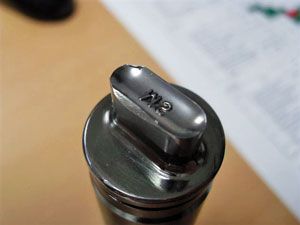
Operating conditions
Inappropriate operating conditions can occasionally lead to catastrophic failure during use of the punches and dies. Again, these issues relate to the delicate nature of the punch tip. The detail in the punch tip is usually described as the cup; this cup forms the profile of the tablet and can contain detail such as embossing or break lines, which effectively reduce the strength of the punch tips. Such problems can manifest themselves in small, difficult-to-detect cracks, chipping of the punch-tip edges, or even a full piece of the tip edge breaking away (see Figure 2). These issues may look insignificant to the naked eye, but because high cyclic loading is applied to the cup many thousands of times per running hour, the tip edge is flexing and bending within the clearance between the punch tip and die bore. If the conditions are not optimized, this can eventually lead to fatigue or brittle fracture, causing the punch tip to fail. These types of failures can be avoided by careful punch and tablet design, correct metallurgical condition, and using the appropriate compaction force.
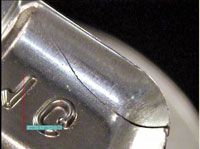
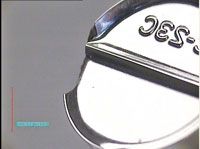
Aggressive formulations
Aggressive formulations can subject the punch tips to adverse effects such as abrasion, pitting, or corrosion when under compression, as shown in Figure 3. The tools are manufactured from hardened and tempered tool steel, yet due to the demanding process, can deteriorate quickly if the tool material is not optimized to suit the formulation being compressed. Certain granules are extremely hard and abrasive and can scratch, wear, and impregnate the steel surface. Other granules can contain corrosive elements that react with the steel. Understanding the nature of the product to be compressed and carefully selecting a material and operating conditions can reduce these effects.

Die wear
Die wear is also quite a common occurrence, especially when compressing hard, abrasive granules and powders. Die wear is also known as “die ringing” because the wear takes place in the area of the die bore where the tablet is compacted. The wear appears in the bore as a double ring (see Figure 4) due to the upper and lower punch tips flexing and bending within the clearance between the tips and the die bores during full compaction. The granule reacts between these surfaces leading to compressive and abrasive wear. When the wear becomes significant, it will lead to problems such as tablet capping or delamination and increased tablet ejection forces. This type of wear can be reduced by using different zones in the die bore where the tablet is compacted or by the selection of a harder, more wear-resistant die material.
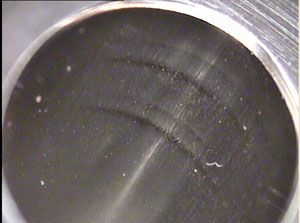
Incompatability of geometry between the punch-head profile and tablet-press cams will lead to premature head wear. The punch heads are subjected to high cyclic loadings, typically 20 kN to 50 kN, many thousands of times per hour of running. If the punches are running tight for any reason, there will be resistance between the punch heads and the cams and rollers, creating high frictional force. This will lead to premature wearing of the heads and eventual fatigue and total breakdown of the metal (see Figure 5). An additional effect of this breakdown will be contamination in the tablet press by the metal particles, leading to expensive damage to tooling, press cams, and compression rollers. This type of damage can be avoided by close monitoring of the tooling condition and good tooling and tablet-press maintenance procedures.

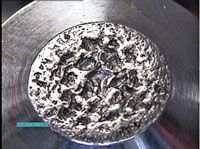
Punch key damage
Another common sight is damage to punch keys (see Figure 6), which is usually the result of handling damage during loading and unloading the tooling in or out of the tablet press. The punch key is an extra component fitted to punches for producing non-round tablets and for punches with multiple tips (usually upper punches) to facilitate accurate alignment of the upper punch tip into the die bore. The key is usually manufactured from a slightly softer material than the body of the punch, which may make it more prone to damage if not handled correctly during loading and unloading. Damage to keys can occur during storage and transportation of tooling, tool cleaning, repair and polishing, or wherever the keys can contact a hard surface. Damage to the keys can be reduced by having a good understanding and appreciation of its function and by taking extra care during the handling, maintenance, and setting processes.

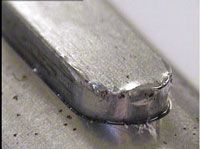
Conclusion
The problems discussed in this article are quite common, although the damage is not always to the extent shown in the images in this article. Damage and wear to tooling result in time-consuming and costly mistakes. If the correct procedures are put in place at the beginning of the process and the correct quality tooling is used, problems like the ones discussed will simply not happen. Employing good care and maintenance practices with both the tooling and the tablet press is crucial.
About the Author
Trevor Higgins is technical director at I Holland, trevor.higgins@iholland.co.uk, tel. +44 (0) 1159726153. All figures are courtesy of the author.
Article DetailsPharmaceutical Technology
Vol. 39, Issue 2
Pages: 58–59
Citation: When referring to this article, please cite as T. Higgins, “Preventing Tablet Tooling Problems,” Pharmaceutical Technology 39 (2) 2015.
Drug Solutions Podcast: A Closer Look at mRNA in Oncology and Vaccines
April 30th 2024In this episode fo the Drug Solutions Podcast, etherna’s vice-president of Technology and Innovation, Stefaan De Koker, discusses the merits and challenges of using mRNA as the foundation for therapeutics in oncology as well as for vaccines.
Drug Solutions Podcast: Gliding Through the Ins and Outs of the Pharma Supply Chain
November 14th 2023In this episode of the Drug Solutions podcast, Jill Murphy, former editor, speaks with Bourji Mourad, partnership director at ThermoSafe, about the supply chain in the pharmaceutical industry, specifically related to packaging, pharma air freight, and the pressure on suppliers with post-COVID-19 changes on delivery.
Pharmaceutical Tariffs Are Imminent: How Industry is Bracing for Impact
April 16th 2025On April 14, 2025, the Trump Administration launched a national security-driven investigation into pharmaceuticals, a move that will likely result in tariffs being placed on pharmaceutical drugs, ingredients, and other components that are imported from outside of the United States.
